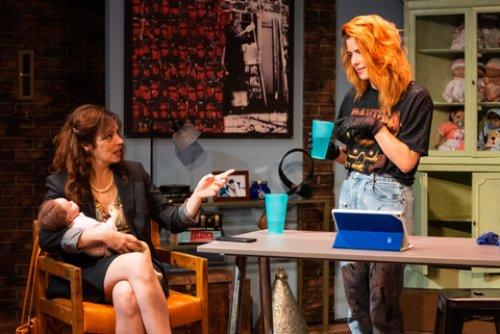Reborning
Two women from different walks of life negotiate loss and abandonment together in this unique, emotionally-driven play.

Lori Triolo and Emily Bett Rickards in a scene frrom Zayd Dohrn’s “Reborning” at the SoHo Playhouse (Photo credit: Russ Rowland)
[avatar user=”Christopher Caz” size=”96″ align=”left” ] Christopher Caz, Critic[/avatar]
When I first heard about this play, Reborning by Zayd Dohrn, I searched the internet on the topic, and after a single Wiki review, I decided that “reborning” was ‘creepy’. I said as much to the theater companion who was to see it with me, Linda, a professional woman of mature years, married more than once but never a mother. Reborning is “the art of transforming manufactured vinyl dolls so that they resemble real human babies.”
In hindsight I can definitely say that my classification of reborning as ‘creepy’ is superficial and dismissive. Because I’m not a woman, I stand in no place to fully appreciate all the layers to the phenomenon that surrounds the subject. In fact, I feel so unqualified to summarize its effects that I’m going to quote Linda, who speculated that “the visceral impact of this piece would hit women the hardest and almost universally, because of the repeated themes: child loss, child abandonment, the inadequacy most women feel when facing motherhood, the battle between wanting a child and wanting to be professionally successful, ‘mutilating’ one’s baby through abortion or by giving it away…those things are gut-level punches to most women of any age.”
I may not be a woman, let alone one who has experienced any of the above traumas, but after seeing this play I can more fully appreciate the subject, at least intellectually. Credit can be given to playwright Zayd Dohrn, a man, for revealing his research through his female characters Kelly (Emily Brett Richards), a reborning doll sculptor, and Emily (Lori Triolo, who also directs), a business woman haunted by the loss of her infant child many years ago.
Kelly is a troubled young woman; she struggles with having been callously injured as a baby and abandoned in a dumpster. Richards plays the role as earnestly as any actor could. Her character is so busy consuming large quantities of alcohol, smoking pot, popping pills, throwing fits and exhibiting other signs of emotional illness that any acting finesse goes unnoticed. The audience feels as alienated by her as the other characters do, which, in the end, results in a prevailing sentiment of pity, albeit from a distance.

Lori Triolo and Emily Bett Rickards in a scene from Zayd Dohrn’s “Reborning” at the SoHo Playhouse (Photo credit: Russ Rowland)
Emily is a menopausal woman who has commissioned a reborn doll from Kelly, one which is intended to meticulously resemble her deceased infant child Eva. Triolo’s depiction of Emily is reserved, uptight and fussy, which makes sense for a woman in a suit. She holds her purse a certain way, wrinkles her nose at unpleasant smells and dusts off places to sit, but Triolo is focused, sincere and vulnerable in the right moments.
Kelly’s boyfriend Daizy (Paul Piaskowski) is appropriately bewildered over his girlfriend’s emotional spiraling out of control. He’s just a regular dude who makes dildos for a living, so he’s completely ill-equipped to deal with a complex girlfriend like Kelly. Piaskowski’s portrayal of Daizy is easy and good-natured, but he sometimes strains under attempts to be funny when his lines are written to be humorous but just aren’t.
All three of the actors have moments in their performances which appear less than organic, but it is most often when they’re written to say or do things which just don’t ring true.
For example, Emily stealing a hit from Kelly’s joint when she’s out of the room or Daizy offering Emily to browse his dildo collection seem like unbelievable behavior between strangers for these personalities. When Daizy tells Kelly he finds her work disgusting, it’s just totally not in line with his simple, supportive character to say such a thing to her in such a casual way, regardless of the fact that he makes rubber phalluses by comparison.

Emily Bett Rickards and Paul Piaskowski in a scene frrom Zayd Dohrn’s “Reborning” at the SoHo Playhouse (Photo credit: Russ Rowland)
The plot turn in which Kelly suddenly believes Emily is her mother is just too great a leap without enough information to suggest the possibility, and the most unbelievable moment of all is when we, the audience, see the Eva doll’s eyes blink. It’d be one thing for Kelly, in her distressed state, to imagine such a thing happening, but for the audience to witness it as well makes it a scene right out of a horror movie and a completely unsuccessful way for us to witness her delusion. These are just a few examples, but there are enough moments like these to jar the sincerity of what is taking place on stage.
Except for some sticky elevator door moments, scene design by Peter Triolo works well together with lighting design by Aaron Porter to provide a flexible space for the director and actors to negotiate, including a clever quick change on the lip of the stage to depict an outdoor setting. Art design by Jo-Marie Triolo gives excellent definition to the different areas of the set.
There is a prevailing sense that the script tries to cover too much intellectual ground on the topic of reborning in too short a time frame, placing a burden on the characters to experience more than would seem realistic in an ordinary world. Nevertheless, through the efforts of the actors and valiant direction by Triolo, this dark play does succeed in bringing to light some of the complexities of motherhood, child loss and abandonment through the very unique reborning lens. Check it out for yourself.
Reborning (through August 3, 2019)
Reality Curves and SoHo Playhouse
SoHo Playhouse, 15 Vandam Street, in Manhattan
For tickets, visit https://www.reborningoffbroadway.com/
Running time: 95 minutes without an intermission






Leave a comment